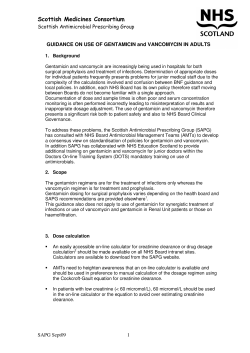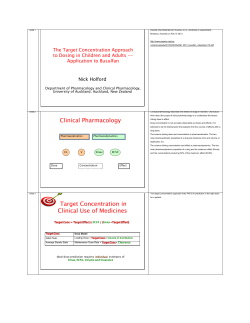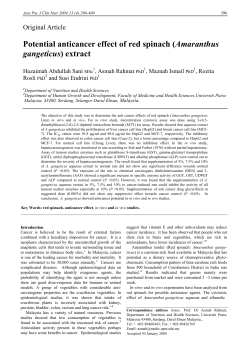
Pharmacokinetics in the critically ill adult patient: Associate Clinical Professor
Pharmacokinetics in the critically ill adult patient: A focus on vancomycin and aminoglycosides Kurt A. Wargo, Pharm.D.,BCPS (AQ-ID) Associate Clinical Professor Auburn University School of Pharmacy Pharmacokinetics • Absorption • Distribution • Metabolism • Elimination • Therapeutic Drug Monitoring • Peaks and troughs Pharmacokinetics in the critically ill Hydrophilic ABX Lipophilic ABX Examples • β-lactams • Aminoglycosides • Vancomycin • Linezolid • Fluoroquinolones • Macrolides • Clindamycin • Tigecycline/Tetracyclines General PK • Low Vd • Primary renal clearance • Low intracellular concentrations • High Vd • Primary hepatic clearance • Good intracellular concentrations Critically Ill PK • Increased Vd • Vd unchanged • Cl ↑ or ↓ based on renal fx • Cl ↑ or ↓ based on hepatic function Roberts et al. Crit Care Med. 2009;37:840-51 Vd changes in the critically ill • Increased Vd of hydrophilic drugs • Hypoalbuminemia and capillary leak (fluid shifts to interstitial spaces) • Decreases serum concentrations • Other factors: • Ventilation • Post-surgical drains • Cardiopulmonary bypass circuits • Burns • No change in Vd of lipophilic drugs Changes to antibiotic half-life • t1/2 = (0.693 X Vd) / Cl • (t1/2 = 0.693 / ke) • Both ↑ Vd and ↓ Cl can increase the half-lives of antibiotics • Management of hypotension increases Cl Effects of critical illness on PK parameters Sepsis Leaky Capillaries Increased CO Normal organ function Organ dysfunction Increased Vd Increased Cl Unchanged Vd Decreased Cl Normal Serum Concentrations High Serum Concentrations Low Serum Concentrations Roberts et al. Crit Care Med. 2009;37:840-51 Pharmacodynamic (PD) Relationships CmaxGoal: Cmax/MIC >10 AUC Concentration (mg/L) Goal: AUC/MIC > 125 for G (-), and >35 for G(+) %T>MIC MIC Goal: %T>MIC = 50% Time (h) T=time; Cmax=maximum concentration; AUC=area under the curve; MIC=minimum inhibitory concentration. Moore RD et al. J Infect Dis. 1987;155:93-99; Gilbert DN. Antimicrob Agents Chemother. 1991;35:399-405. Pharmacodynamic Properties Antibiotics PD Parameter Time-Dependent ConcentrationDependent Mixed β-lactams Carbapenems Erythromycin Clarithromycin Aminoglycosides Metronidazole Daptomycin Vancomycin Linezolid Fluoroquinolones Azithromycin Tigecycline Tetracyclines T > MIC Cmax / MIC AUC24 / MIC When to draw peaks and troughs • Steady State: 5 half-lives of the drug (steady state) Vancomycin Vancomycin Exhibits both concentration- and time-dependent characteristics Optimally needs to spend 100% of time above MIC AUC/MIC > 400 Absorption: IV only (PO no systemic absorption) Distribution: Widely in tissues and fluids (poor lung and CSF penetration); avg: 0.7 L/kg (relatively hydrophilic) Metabolism: Negligible Elimination: Kidneys Vancomycin Therapeutic Drug Monitoring Ototoxicity with high peaks (>80 mg/dL) Nephrotoxicity with high troughs (>25 mg/dL) and in combination with other nephrotoxic drugs Red Man’s Syndrome with fast infusion (infuse no faster than 1 g/hr) Ideal Levels ▪ Trough of 15-20 mg/dL Vancomycin dosing guidelines conundrum • Am J Health-Syst Pharm. 2009; 66:82-98 • “AUC/MIC is most useful PD parameter to predict effectiveness” • “Increasing trough concentrations to 15-20 mg/L to attain AUC/MIC of 400 is desirable” • “Trough serum concentrations can be used as a surrogate marker of AUC/MIC” Vancomycin “traditional” dosing • Cellulitis/Endocarditis • Dose: 10 – 15 mg/kg of actual body weight • Interval: Every 1.5 half lives • Pneumonia/Meningitis/Abscess—Matzke Nomogram • Loading Dose: 25 mg/kg of actual body weight • Maintenance Dose: 19 mg/kg of actual body weight • Interval: Every 2 half lives • DO NOT EXCEED 4 grams daily Vancomycin “traditional” dosing t1/2 = 0.693 / [(0.00083 x CrCl) + 0.0044] CrCl = [(140 – age) x Weight] / (72 x Cr) [x 0.85 if female] Weight is lower of actual or ideal, or an adjusted weight if patient is obese Ideal Weight Male: 50 + (2.3 x inches > 60) Ideal Weight Female: 45.5 + (2.3 x inches >60) Adjusted Weight: 0.4(Actual – Ideal) + Ideal Vancomycin “AUC/MIC” dosing • Goal AUC/MIC = 400 • AUC/MIC = Dose24 / [((CrCl x 0.79) +15.4) x 0.06] • Dose24 = 400 x [((CrCl x 0.79) +15.4) x 0.06] • Wargo Nomogram CrCl (mL/min) AUC Dose (mg)* > 125 1500 Q12h 100-124 1250 Q12h 70-99 1000 Q12h 50-69 1500 Q24h 30-49 1000 Q24h *Assumes MIC = 1 Step-wise approach to traditional dosing of Vancomycin 1. Determine if loading dose is necessary 2. Calculate maintenance dose (either 10-15 mg/kg or 19 mg/kg of actual body weight) 3. Calculate necessary weight for CrCl equation 4. Calculate CrCl 5. Calculate half-life 6. Calculate dosing interval 7. Determine when/if you want to check a trough Vancomycin Example 1 • HB is a 71 year old male admitted for MRSA pneumonia. • Height: 6’0” • Weight: 185# • Cr: 1.3 mg/dL • Ideal weight: 78 kg • Actual weight: 84kg • CrCl: 58 mL/min • t1/2: 13 hrs Vancomycin Example 1 Loading dose: 25 mg/kg x 1 = 2000 mg Maintenance dose: 19mg/kg = 1500 mg Interval: Every 2 half lives = 24 hrs Goal trough: 15 – 20 mg/dL Order: Vancomycin 2000 mg IV x 1, then 1500 mg IV q24hrs Vancomycin Example 1 (AUC dosing) • CrCl = 58 • Dose = 1500 mg IV Q24h, assuming MRSA has an MIC = 1 mg/L Vancomycin Example 2 • AJ 51 year old female with MRSA cellulitis • Wt: 285 # • Ht: 5’4” • Cr: 1 mg/dL • Ideal Wt: • 55 kg • Actual Wt: • 130 kg • CrCl: • 105 mL/min (Adjusted wt of 85 kg) • t1/2: • 8 hrs Vancomycin Example 2 • Dose: • 10-15 mg/kg = 1300 – 2000 mg • Interval: • 1.5 x t1/2 = 12 hrs • What you order: • Vancomycin 2000 mg IV q12hrs • When do you check a trough? • In 40 hrs or before the 3rd or 4th dose Vancomycin Example 2 (AUC dosing) • CrCl = 105 mL/min • Dose = 1250 mg IV Q12h Vancomycin “what-if’s” • What if the trough comes back high (>20 mg/dL)? • Option 1: Hold a dose, then increase interval • Option 2: Increase your interval without holding dose (20-25 mg/dL range) • Option 3: Do nothing—ASSESS Patient • What if the trough comes back too low? • Option 1: Decrease the interval (RARE to go to q8h dosing) • Option 2: Increase the dose • Option 3: Change therapy • Option 4: Do nothing—ASSESS Patient • What if the creatinine increases on therapy? • Check the volume status of the patient • Consider changing therapy Aminoglycosides Aminoglycosides • Tobramycin, Gentamicin, Amikacin • Concentration-dependent • Peak level should be 10x the MIC for optimal bactericidal activity • Absorption: IV/IM, Not PO • Distribution: Hydrophilic (Vd ≈ 0.24 L/kg) • Metabolism: Negligible • Excretion: Urine The Bad Reputation Ototoxicity • Associated with high peaks, extremes in age, >14 days of therapy, concurrent meds (loops and vanco) • Alters Na-K pump, changing electrical potential and osmotic pressure in the endolymph, leading to cochlear then vestibular dysfunction. If recognized early (fullness and tinnitus), it is reversible. • Vestibular damage is permanent: vertigo, nausea, dizziness, nystagmus Nephrotoxicity • Associated with high troughs, extremes in age, volume contraction, >14 days therapy, meds (vanco, ampho B) • Excreted via proximal tubule, but when [ ] is high, it is absorbed via pinocytosis in the brush border cells. Vacuole ruptures and AG interferes with phosphorylation and ATP synthesis—cell death • Early sign: casts in urine • Generally reversible upon discontinuation Neuromuscular blockade • RARE, but fatal • Greatest risk in patients with Myasthenia Gravis or on NMBAs • Hypocalcemia, hypomagnesemia, and calcium-channel blocker use may all contribute • AG interferes with presynaptic uptake of Ca 2+ causing immediate release of acetylcholine and postsynaptic nerve binding • Reverse with Ca-gluconate or Neostigmine • Manifestations: dilated pupils, weak respiration, flaccid paralysis So what is their utility??? Any infection where Pseudomonas aeruginosa is suspected and you want to “double cover” → increasing FQ resistance Aminoglycoside dosing • Tobramycin/Gentamicin: Traditional vs. High-dose • Traditional: Peaks range from 4 mg/dL for UTIs to 10 mg/dL for pneumonia; Troughs < 2 mg/dL • High-dose: Attempting to get a peak of at least 20 mg/dL; Troughs: undetectable • Amikacin: Reserved for multi-drug resistant organisms High-dose aminoglycosides • Advantages: • Easier • Optimizes pharmacodynamics • Can decrease incidence of adverse reactions by only using for ≤ 5 days • Disadvantages: • Not for use in patients with a large Vd or rapid elimination • Burns, dialysis/renal failure, pregnancy, peds, ascites Aminoglycoside dosing • High-Dose Tobra/Gent • Dose: 5-7 mg/kg (actualor adjusted if obese) • Do not exceed 600 mg • Interval: dependent on 10-hour random level • Goal trough: Undetectable, in order to allow kidneys time to recover from high dose, a drug-free period of ≈ 6 hours is necessary. High-dose aminoglycoside nomogram (Tobra/Gent) “Traditional” dosing Tobra/Gent • UTI: 1.25 – 1.5 mg/kg every 2 t 1/2 • Pneumonia/Sepsis: 2 – 2.5 mg/kg every 3 t 1/2 • Endocarditis: 1 mg/kg every 2 t 1/2 • t1/2: 0.693 / [(0.00285 x CrCl) + 0.015] • Check BOTH Peak and Trough around 5 half-lives 30 minutes before and after dose Step-wise approach to dosing AGs 1. Determine if pt. is candidate for high-dose 2. Calculate CrCl 3. Calculate dose / determine appropriate wt. a. If on high-dose, check 10-hr random level and plot on nomogram b. If on traditional dose, check peak AND trough at 5 half-lives a. Calculate t1/2 and interval Aminoglycoside Example 1 • GM is a 77 year old male who develops VAP, as one of your 3 drug regimen, you select tobramycin. • Ht: 5’8” • Wt: 78 kg • Cr: 1 mg/dL 1. What dose of tobramycin would you use? 2. What interval? 3. When would you check levels? Aminoglycoside Example 1 • Dose: • 5-7 mg/kg ; what weight do you use? • Actual: 78 • 390 – 546 mg • Interval/when to check levels: • Start with q24h, but after 1 st dose check a 10-hr level to determine if q24h will work • What you order: • Tobramycin 520 mg IV Q24, check random level 10 hrs after first dose. Aminoglycoside Example 2 • FJ is a 47 year old cirrhotic female with pneumonia. It is decided to start her on gentamicin therapy. • Ht: 5’8” • Wt: 75 kg • Cr: 0.8 mg/dL 1. What dose of gent do you recommend? 2. What interval? 3. When do you want to check levels? Aminoglycoside Example 2 • Is the patient a candidate for high-dose? • No—Cirrhosis/Ascites • CrCl: • 50 mL/min • Dose: • 2 - 2.5 mg/kg; what weight do you use? • 75 kg (actual wt) • 150 – 190 mg Aminoglycoside Example 2 • Interval: • t1/2: 0.693/ [(0.00285 x 50) + 0.015] • t1/2 = 4.4 hrs • Interval = (3 x 4.4) = 13hr • When do you check levels? • 5 x 4.4 = 18 hrs • What you order: • Gentamicin 160 mg IV q12h, check peak/trough around 3rd dose Aminoglycoside “what-if’s” • What if the peak comes back too low? • Increase the dose, or decrease the interval • What if the peak comes back too high (>20 mg/dl)? • Decrease the dose, or increase the interval • What if the trough is too high (>2 mg/dL)? • Increase the interval • What if the creatinine increases on therapy? • Assess volume status • Obtain U/A—casts • Consider changing therapy Summary • Critical illness alters PK of drugs • Vanco and AGs are hydrophilic, so Vd can be increased • Vancomycin dosing has become controversial • AUC/MIC has the most evidence • Aminoglycoside dosing should employ “high-dose” in order to maximize PD
© Copyright 2025





















